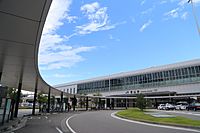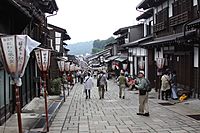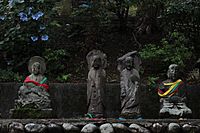Toyama (city) facts for kids
Quick facts for kids
Toyama
富山市
|
|||
|---|---|---|---|
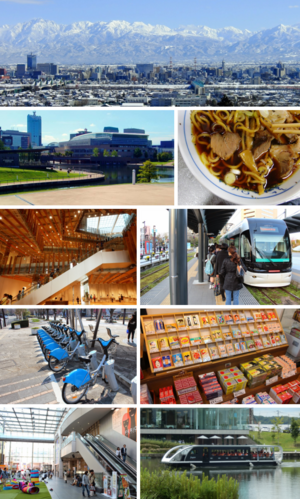
(From top, left to right : Kureha Hills •Tomiiwa Canal Kansui Park • Toyama Black• Toyama Glass Museum• Toyama Light Rail • Avile • Toyama Drug Sales • Sogawa Ferio • Tomiiwa Canal)
|
|||
|
|||
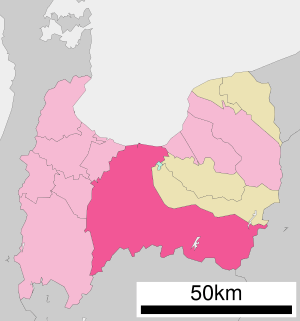
Location of Toyama in Toyama Prefecture
|
|||
| Country | |||
| Region | Chūbu (Hokuriku) | ||
| Prefecture | |||
| First official recorded | 6th century AD | ||
| City settled | April 1, 1889 | ||
| Area | |||
| • Core city | 1,241.77 km2 (479.45 sq mi) | ||
| Population
(June 1, 2019)
|
|||
| • Core city | 415,844 | ||
| • Density | 334.8801/km2 (867.335/sq mi) | ||
| • Metro
(2015)
|
1,066,328 (16th) | ||
| Time zone | UTC+9 (JST) | ||
| Postal code |
930-8510
|
||
| Symbols | |||
| • Tree | Zelkova serrata | ||
| • Flower | Helianthus annuus | ||
| • Flowering tree | Camellia japonica | ||
| Phone number | 076-431-6111 | ||
| Address | 7-38 Shinsakuramachi, Toyama-shi, Toyama-ken | ||
Toyama (富山市, Toyama-shi, Japanese: [toꜜjama]) is a cool city in Japan. It is the capital of Toyama Prefecture. You can find it on the coast of the Sea of Japan. This city is in the Chūbu region on central Honshū island. It is about 200 kilometers north of Nagoya and 300 kilometers northwest of Tokyo.
As of June 2019, Toyama had about 415,844 people living in it. The city covers an area of 1241.77 square kilometers.
Contents
About Toyama City
Toyama is known as an "environmental model city." The Japanese government gave it this title. This means the city works hard to reduce harmful gases that cause climate change.
City Views
Toyama has many interesting places to see. You can explore its historic castle. There are also modern city areas and beautiful parks.
Geography of Toyama
Toyama is in the middle of its prefecture. It is a coastal city right by the Sea of Japan. The city shares borders with Gifu Prefecture. It also borders other towns like Imizu and Namerikawa. These towns are also by the sea.
The closest big city is Kanazawa. Kanazawa is the capital of Ishikawa Prefecture. It is about 65 kilometers away from Toyama.
Toyama's Climate
Toyama has a climate with hot, humid summers. Its winters are cool. It rains a lot throughout the year. July, September, and November to January are especially rainy.
Even though winters are mild, Toyama gets a lot of snow. This is because it is near the Sea of Japan. On average, about 3.8 meters of snow falls each winter. Most of this snow falls from December to March. Sometimes, there can be huge snowfalls!
| Climate data for Toyama (1991−2020 normals, extremes 1939−present) | |||||||||||||
|---|---|---|---|---|---|---|---|---|---|---|---|---|---|
| Month | Jan | Feb | Mar | Apr | May | Jun | Jul | Aug | Sep | Oct | Nov | Dec | Year |
| Record high °C (°F) | 20.9 (69.6) |
22.5 (72.5) |
25.7 (78.3) |
32.4 (90.3) |
33.3 (91.9) |
36.4 (97.5) |
38.8 (101.8) |
39.5 (103.1) |
38.3 (100.9) |
33.3 (91.9) |
29.2 (84.6) |
24.8 (76.6) |
39.5 (103.1) |
| Mean daily maximum °C (°F) | 6.3 (43.3) |
7.4 (45.3) |
11.8 (53.2) |
17.6 (63.7) |
22.7 (72.9) |
25.7 (78.3) |
29.8 (85.6) |
31.4 (88.5) |
27.0 (80.6) |
21.6 (70.9) |
15.7 (60.3) |
9.5 (49.1) |
18.9 (66.0) |
| Daily mean °C (°F) | 3.0 (37.4) |
3.4 (38.1) |
6.9 (44.4) |
12.3 (54.1) |
17.5 (63.5) |
21.4 (70.5) |
25.5 (77.9) |
26.9 (80.4) |
22.8 (73.0) |
17.0 (62.6) |
11.2 (52.2) |
5.7 (42.3) |
14.5 (58.1) |
| Mean daily minimum °C (°F) | 0.2 (32.4) |
0.1 (32.2) |
2.6 (36.7) |
7.4 (45.3) |
12.9 (55.2) |
17.7 (63.9) |
22.1 (71.8) |
23.2 (73.8) |
19.1 (66.4) |
13.1 (55.6) |
7.3 (45.1) |
2.5 (36.5) |
10.7 (51.3) |
| Record low °C (°F) | −11.9 (10.6) |
−11.1 (12.0) |
−7.0 (19.4) |
−2.2 (28.0) |
2.3 (36.1) |
7.7 (45.9) |
13.0 (55.4) |
14.1 (57.4) |
8.9 (48.0) |
1.9 (35.4) |
−2.0 (28.4) |
−8.5 (16.7) |
−11.9 (10.6) |
| Average precipitation mm (inches) | 259.0 (10.20) |
171.7 (6.76) |
164.6 (6.48) |
134.5 (5.30) |
122.8 (4.83) |
172.6 (6.80) |
245.6 (9.67) |
207.0 (8.15) |
218.1 (8.59) |
171.9 (6.77) |
224.8 (8.85) |
281.6 (11.09) |
2,374.2 (93.47) |
| Average snowfall cm (inches) | 104 (41) |
84 (33) |
17 (6.7) |
1 (0.4) |
0 (0) |
0 (0) |
0 (0) |
0 (0) |
0 (0) |
0 (0) |
0 (0) |
49 (19) |
253 (100) |
| Average precipitation days (≥ 0.5 mm) | 23.7 | 19.9 | 18.2 | 13.5 | 12.0 | 12.1 | 15.3 | 11.6 | 13.7 | 14.2 | 17.9 | 23.0 | 194.9 |
| Average relative humidity (%) | 82 | 78 | 72 | 68 | 70 | 78 | 79 | 77 | 78 | 77 | 77 | 81 | 76 |
| Mean monthly sunshine hours | 68.1 | 89.7 | 135.9 | 173.6 | 199.9 | 154.0 | 153.3 | 201.4 | 144.2 | 143.1 | 105.1 | 70.7 | 1,647.2 |
| Source: Japan Meteorological Agency | |||||||||||||
Population of Toyama
The number of people living in Toyama has grown for a long time. Recently, the population has stayed about the same.
| Historical population | ||
|---|---|---|
| Year | Pop. | ±% |
| 1970 | 350,085 | — |
| 1980 | 391,554 | +11.8% |
| 1990 | 408,942 | +4.4% |
| 2000 | 420,804 | +2.9% |
| 2010 | 421,953 | +0.3% |
| 2020 | 413,938 | −1.9% |
Neighboring Towns and Cities
Toyama is surrounded by several other places. These include:
- Imizu
- Namerikawa
- Tonami
- Nanto
- Kamiichi
- Tateyama
- Funahashi
- Ōmachi
- Hida
- Takayama
History of Toyama
Early Times
The area where Toyama city is now was once part of an old province called Etchū Province. The Toyama Plain has good farmland. It has been an important place for travel and strategy since ancient times.
Warring States Period
During the Sengoku period (a time of many wars), Toyama was often a battlefield. A powerful leader named Sassa Narimasa took control. He built a castle town around Toyama Castle. He also managed the rivers to help farming grow.
Edo Period Development
Later, during the Edo period, the area became part of the Kaga Domain. The Maeda clan ruled it. They encouraged industries like making Chinese medicine and washi (Japanese paper).
Sea travel routes improved, helping these businesses grow. Toyama became famous across Japan for its medicine.
Recent History
Modern Growth
In 1889, Toyama officially became a city. It was one of the first 30 cities in Japan. The city grew economically. It developed heavy industries and chemical factories. These industries used the area's rich hydroelectric power.
Toyama became a very important city on the Sea of Japan. It had good water, drainage, and strong farming. Its fishing, trade, and manufacturing industries also did well.
World War II and Rebuilding
During World War II, Toyama faced great destruction. On the night of August 1-2, 1945, the city was almost completely destroyed. At that time, Toyama was a center for making aluminum, ball-bearings, and special steel. The city had about 150,000 people. After the war, Toyama was rebuilt and continued to grow.
City Mergers in 2005
On April 1, 2005, Toyama city became much larger. It merged with several nearby towns and villages. These included Ōsawano, Ōyama, Fuchū, Yatsuo, Hosoiri, and Yamada. This merger helped the city expand its area and population.
Sister Cities
Toyama has special connections with cities around the world. These are called sister cities. They help promote friendship and understanding.
| City | Country | State | Since |
|---|---|---|---|
| Mogi das Cruzes | São Paulo | November 8, 1979 | |
| Durham | North Carolina | June 13, 1989 | |
| Wellington | New South Wales | August 24, 1992 | |
| Gwangju | Special cities | 2011 |
- Friendship City
Toyama also has one "friendship city":
| City | Country | State | Since |
|---|---|---|---|
| Qinhuangdao | Hebei | May 8, 1981 |
Economy of Toyama
Several important companies are based in Toyama. Hokuriku Electric Power Company, which provides electricity to the region, is here. Nachi-Fujikoshi, a company that makes parts for machines and robots, is also headquartered in Toyama. The software company INTEC is located here too.
Local banks like Hokuriku Bank are also important to the city's economy.
Education in Toyama
Toyama has many schools and universities. This shows its focus on learning.
Colleges and Universities
Students can attend several higher education institutions:
- Toyama College
- Toyama National College of Technology
- Toyama Prefectural University
- Toyama University of International Studies
- University of Toyama
Schools for Younger Students
The city government runs 65 public elementary schools. It also operates 26 public middle schools. There are also national government schools. Toyama Prefecture runs fourteen public high schools. There are also seven private high schools. Toyama Shogyo High School is a special high school for business studies.
Getting Around Toyama
Toyama has many ways to travel. You can get around by air, train, tram, or road. It also has a port for sea travel.
Air Travel
Airport
- Toyama Airport is the main airport for the city.
Train Travel
High-Speed Rail
- Hokuriku Shinkansen: This is a fast bullet train line. It stops at Toyama Station.
Local Train Lines
There are several local train lines connecting different parts of Toyama and beyond.
- Takayama Main Line: Connects many stations like Inotani and Toyama.
- Takayama Main Line: Also serves the Inotani area.
- Ainokaze Toyama Railway Line: Stops at stations like Kureha and Toyama.
- Main Line: Runs from Toyama to Etchū-Sangō.
- Kamidaki Line: Connects Inarimachi to Daisenji.
- Tateyama Line: Serves areas like Arimineguchi.
Tramways
Toyama also has a tram system for getting around the city.
- Toyama Light Rail Toyamakō Line
- Toyama City Tram Line
Roads
Expressway
 Hokuriku Expressway : This major road connects Toyama to other cities.
Hokuriku Expressway : This major road connects Toyama to other cities.
National Routes
Several national routes pass through Toyama, making it easy to drive around.
 National Route 8
National Route 8 National Route 41
National Route 41 National Route 359
National Route 359 National Route 360
National Route 360 National Route 415
National Route 415 National Route 471
National Route 471 National Route 472
National Route 472
Sea Travel
Seaport
- Port of Toyama is an important port for shipping and trade.
Fun Places to Visit in Toyama
Toyama has many exciting places for visitors to explore.
- Botanic Gardens of Toyama: A beautiful place to see plants.
- Toyama International Conference Center: A modern building for events.
- Toyama Castle: A historic castle with a museum.
- Toyamaken Gokoku Shrine: A peaceful shrine.
- Toyama Chukyoin: Known as the smallest Shinto shrine.
- Museum of Modern Art of Toyama: Features modern artworks.
- Toyama Athletic Recreation Park Stadium: Home to the local football team, Kataller Toyama.
- Toyama Glass Art Museum: A museum dedicated to glass art.
- Yasuda Castle ruins: The remains of an old castle, a National Historic Site.
- Sugusaka Site: An important archaeological site from the Japanese Paleolithic period.
- Kitadai Site: A Jomon period site, also a National Historic Site.
- Ōzuka-Senbōyama Sites: Ancient settlement ruins and burial mounds from the Yayoi period.
- Kurobe Dam: A very large and impressive dam.
Culture and Events
Festivals and Fun Events
Toyama hosts unique festivals that show off its culture.
- Toyama Chindon Contest: This fun event happens every April. "Chindon" are musical street performers who advertise. Many groups join, and it attracts many tourists.
- Kaze No Bon: This special festival takes place from September 1 to 3. It is held in the Yatsuo region.
Famous People from Toyama
Many talented people come from Toyama.
- Rui Hachimura: A professional basketball player.
- Gaku Matsumoto: An actor.
- Eikichi Minato: A politician and former Mayor of Toyama.
- Ryūzō Sejima: A Japanese army officer and business leader.
- Koichi Tanaka: A chemist who won the Nobel Prize in Chemistry in 2002.
- Tamisuke Watanuki: A politician.
- Kaede Yamada: A member of the Korean girl-group tripleS.
See also
 In Spanish: Toyama para niños
In Spanish: Toyama para niños













